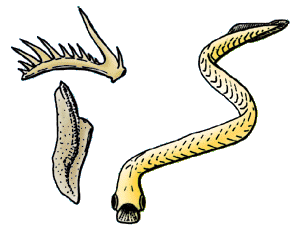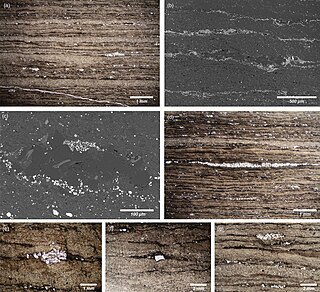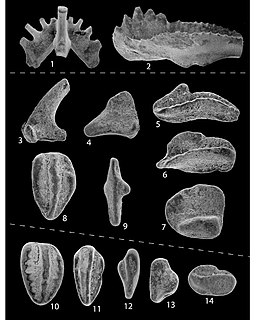
Conodonts are extinct agnathan chordates resembling eels, classified in the class Conodonta. For many years, they were known only from tooth-like microfossils found in isolation and now called conodont elements. Knowledge about soft tissues remains limited. The animals are also called Conodontophora to avoid ambiguity.

Promissum is an extinct genus of conodonts, primitive chordates, that lived during the Upper Ordovician period.

The Wheeler Shale is a Cambrian (c. 507 Ma) fossil locality world famous for prolific agnostid and Elrathia kingii trilobite remains and represents a Konzentrat-Lagerstätten. Varied soft bodied organisms are locally preserved, a fauna and preservation style normally associated with the more famous Burgess Shale. As such, the Wheeler Shale also represents a Konservat-Lagerstätten.
Prioniodontida, also known as the "complex conodonts", is a large clade of conodonts that includes two major evolutionary grades; the Prioniodinina and the Ozarkodinina. It includes many of the more famous conodonts, such as the giant ordovician Promissum (Prioniodinina) from the Soom Shale and the Carboniferous specimens from the Granton Shrimp bed (Ozarkodinina). They are euconodonts, in that their elements are composed of two layers; the crown and the basal body, and are assumed to be a clade.

The Soom Shale is a member of the Late Ordovician (Hirnantian) Cederberg Formation in South Africa, renowned for its remarkable preservation of soft-tissue in fossil material. Deposited in still waters, the unit lacks bioturbation, perhaps indicating anoxic conditions.
Ellisonia is an extinct genus of conodonts in the family Ellisoniidae.
Maurice Goldsmith Mehl was an American paleontologist. A longtime professor in the Department of Geology at the University of Missouri, Mehl was a founding member and officer of the American Association of Petroleum Geologists. Mehl was a fellow of the Geological Society of America (1922), the Paleontological Society, and the American Association for the Advancement of Science.
Edward B. Branson was an American geologist and paleontologist. He worked at the University of Missouri.

Polygnathus is an extinct genus of conodonts.
Spathognathodus is an extinct conodont genus in the family Spathognathodontidae. It is a non Platform conodont, from the Pennsylvanian (Caboniferous).
Gondolella is an extinct genus of conodonts in the family Gondolellidae.
Heinz Walter Kozur was a German paleontologist and stratigrapher.
Hertzina is an extinct genus of conodonts in the family Furnishinidae. Fossils can be found in the Wheeler Shale Cambrian fossil locality in Utah, United States.
Wilbert Henry Hass (1906-1959) was an invertebrate paleontologist specializing in the study of conodonts. He joined the Section of Paleontology and Stratigraphy of the United States Geological Survey (USGS) in 1930 when he was appointed Junior Scientific Aid. He was promoted to the rank of Geologist in 1940 and remained with the USGS for the remainder of his life.
Neognathodus is an extinct genus of conodonts.
Cystodictya is an extinct genus of prehistoric bryozoans in the extinct family Cystodictyonidae.






